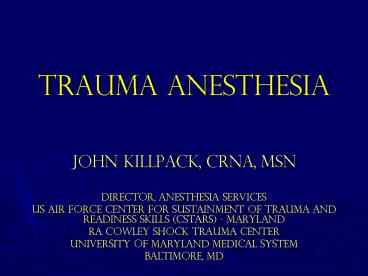Trauma Anesthesia - PowerPoint PPT Presentation
1 / 32
Title: Trauma Anesthesia
1
Trauma Anesthesia
- John Killpack, CRNA, MSN
- Director, Anesthesia Services
- US Air Force Center for Sustainment of Trauma and
Readiness Skills (CSTARS) - Maryland - RA Cowley Shock Trauma Center
- University of Maryland Medical System
- Baltimore, MD
2
EXAMINATION If thou examinest a man having a
dislocation in a vertebra of his neck, shouldst
thou find him unconscious of his two arms (and)
his two legs on account of it, while his phallus
is erected on account of it, (and) urine drop
from his member without his knowing it ...
DIAGNOSIS Thou shouldst say concerning him
An ailment not to be treated From incomplete
Egyptian papyrus circa 1600 BC
3
1856Airway clearance introduced Marshall Hall
correctly added airway and breathing to the
initial steps in resuscitation.
1941 First Trauma Center Birmingham Accident
Hospital and Rehabilitation Centre, Birmingham,
UK
1774 First Successful Trauma ResuscitationHumane
Society, London UK
1971Designation of Trauma Centers first
established by US state lawIllinois, USA
2003 Trauma Centers in United States Level I
190 Level II 263 Level III 251 Level IV-V 450
1797Dominique-Jean Larrey designed the Ambulance
Volante or 'flying ambulances' to evacuate
casualties from the battlefield.
1918Original data supporting the 'Golden Hour'
concept produced from French World War I data.
1966 First US Civilian Trauma UnitCook County,
Chicago
1896First Car vs. Pedestrian Death17th August
1896Crystal Palace, London, UK
4
Trauma awareness
5
Interesting Trivia
- Direct costs of trauma 7 total health care
expenditures - 1/3 of hospital admissions
- (19 million hospital days)
- gt cardiac care, 4X gt cancer
- Elderly 33 of trauma care, are 5X more likely
to die from trauma
6
Nationwide Incidence of Trauma by Age
7
Nationwide Incidence and Death Rates by Mechanism
of Injury
8
Revised Trauma Score (RTS)
0.9368 GCS 0.7326 SBP 0.2908 RR Revised
Trauma Score
9
Pathophysiology
- Blood loss leads to Hypovolemia
- Activation of hypothalamic-pituitary-adrenal axis
- Renin/ angiotensin
- Vasopressin
- Acth
- Catecholamine release
- Hyperglycemia
10
Blood Loss
- Where does blood loss happen?
- What is shock?
11
hypovolemia
12
Resuscitation
- Responder vs. non-responder
- When is enough enough?
- Fluid choice
- I cant see the benefit of putting water into a
leaking wine skin
13
Hypothermia
- Cause
- Effects
- Increased Oxygen demand
- Decreased peripheral perfusion
- Coagulopathy
- Decreased immune response/ healing
- Treatments
14
ARDS
- High incidence in trauma victims
- Long bone fractures
- Head injuries
- Multiple transfusions
- Pulmonary/ thoracic injuries
- sepsis
- Signs and symptoms?
- Onset?
- Intraoperative measures?
15
Assume
- Full Stomach
- Cervical Spine Injury with Blunt Force
- hypotension with tachycardia from hypovolemia
- altered LOC from injury/ hypoperfusion/hypoxia,
not just intoxication - hypothermia
- The worst until proven otherwise
16
requirements
- Method to secure airway
- Induction drugs/ amounts?
- Sniffing position?
- 2 large bore IV
- Subclavian vs. IJ cortis
- Method to deliver high fluid volumes
- Ris vs. level one
17
Skills to Master
- Fluid Management
- Hypothermia
- Coagulopathies
- Electrolyte disturbances
- Effects of rapid transfusion on multiple organ
systems
18
Skills to Master, Cont
- Inline Intubation/ Control Traumatized Airway
19
Airway Management challenges
- RSI
- Cervical spine injury
- Airway injury
- Suboptimal conditions
- Options?
- Awake nasal intubation
20
Interesting Airway Consults
- 16 y.o. male riding ATV collided with tree
- Walked 1.5 miles to home, called ems
- Vs stable, Speech slightly slurred, gcs 15
- Left radial pulse lt right
- 100 SAT on 10 L/min nrb
- Reported stick in the neck
21
Pre Hospital
- Report
- Mechanism of injury
- Glascow Coma Score (GCS) including extremity
check - A. M. P. L. E.
- Lethal six
22
Monitors
- Standard
- eyes
- Questions
23
Assessment
- Rapid Identification and Treatment of life
threatening injuries - Primary Survey
- 1. Airway w/ CSpine
- 2. Breathing
- 3. Circulation with
- Hemorrhage Control
- 4. Disability
- 5. Expose
- Secondary Survey
- Head to toe assessment/ XRays, tubes
24
Pre-operative assessment
- IDEAL The preoperative visit is ideally
accomplished 1-2 days beforesurgery, ideally by
the anesthesia provider who will be providing the
anesthetic. During the visit, the preoperative
status of the patient is evaluated by a thorough
review of the chart and interview followed by a
physical examination. - REALITY Found down, no history
Trauma Anesthesia Requires Maximum Flexibility
25
Intra Operative
- Goal maintain homeostasis
- ABCDEs
- Minimum requirements
- Serial Assessments
- Monitor for new, life threatening variables
26
Post operative
- Continually reassess patient
- Serial labs
- Post op intubation likely
- Possible transfer to major center
27
Abdominal Trauma
- S/s
- Diagnostic tests
- Blunt vs. penetrating Injury Pattern
- Regions of the abdomen
28
Surgeon vs. radiologist
- Angiography
- stable liver/ spleen bleed
- Identification mesenteric/ celiac artery bleed
- Embolization
- Exploratory laparatomy
- Penetrating
- Blunt with evidence internal bleed
- Injured diaphragm
- Injury to bladder, ureters
- CT evidence of pancreatic, GI, kidney
- Unstable liver/ spleen bleed
29
neurotrauma
- Two Goals
- Maintain perfusion
- Maintain oxygenation
- ICP reduction
- Other issues
30
Neuro trauma, cont.
31
Lessons I have Learned
- Epinephrine is your friend
- Know your vascular anatomy
- Always Double Glove!
- One 14 g in the AC is worth two triple lumens in
the IJ - Bullets and blades make little _at_ out of
everyone - Universal Precautions arent just for JCAHO
visits - Trauma providers are lifeguards for the shallow
end of the gene pool
32
Questions?





























![[PDF] Stoelting's Anesthesia and Co-Existing Disease 8th Edition Ipad PowerPoint PPT Presentation](https://s3.amazonaws.com/images.powershow.com/10100186.th0.jpg?_=20240816067)
![[PDF] Stoelting's Anesthesia and Co-Existing Disease: Stoelting's Anesthesia and Co-Existing Disease E-Book Free PowerPoint PPT Presentation](https://s3.amazonaws.com/images.powershow.com/10100188.th0.jpg?_=20240816067)
